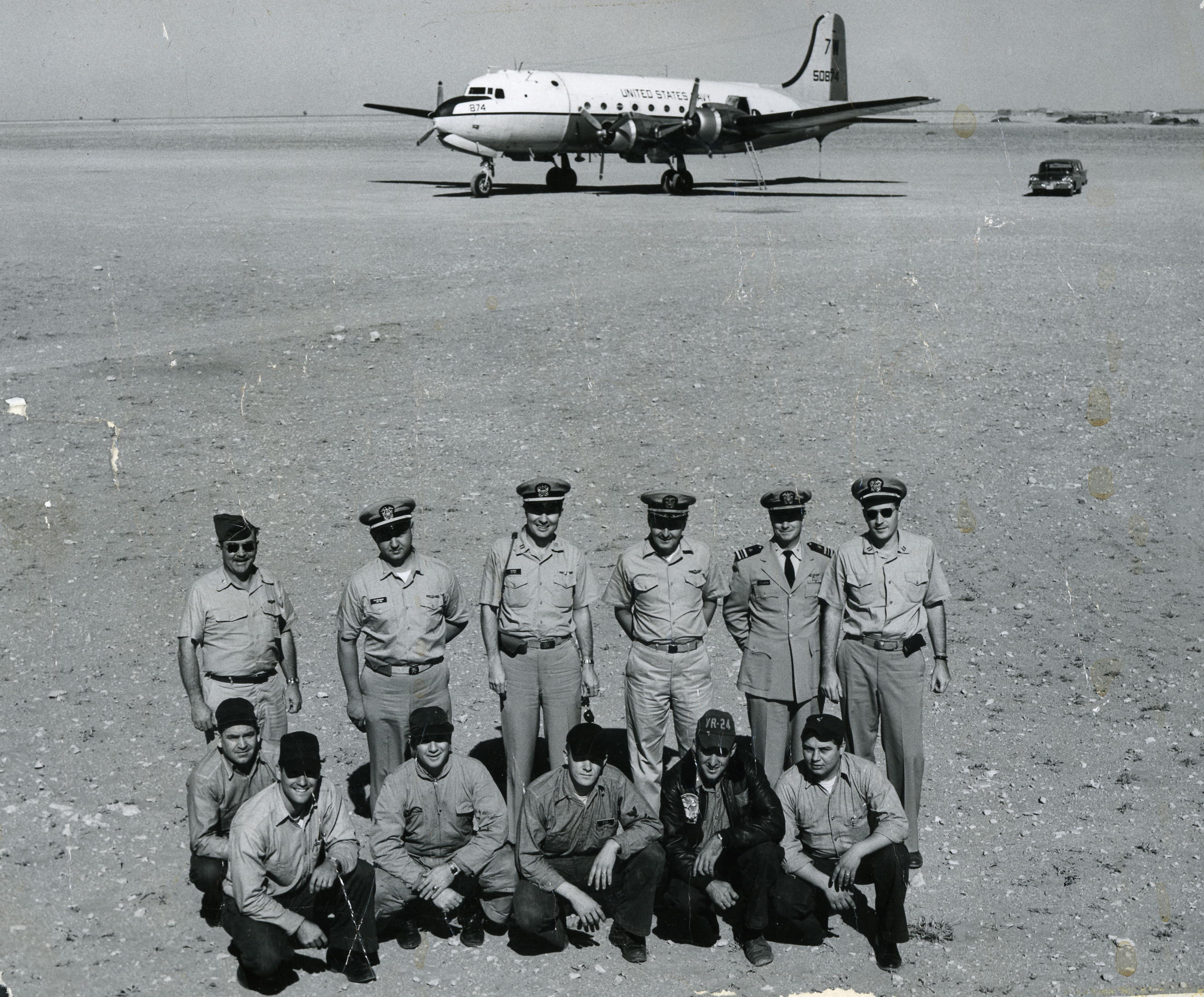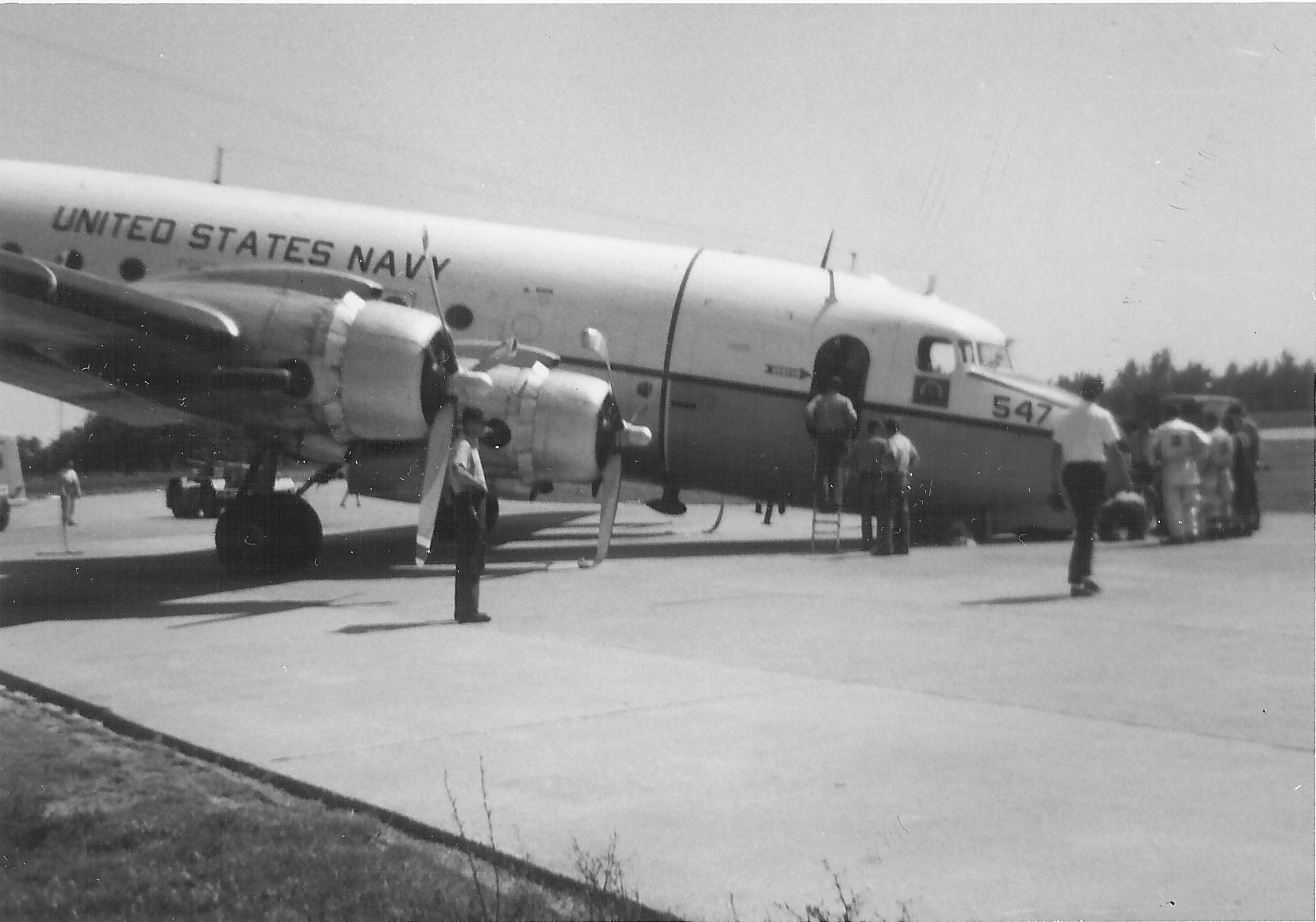|
|
Next Page
Go Direct to Ops Summaries and Prop Wash Page (1),
(2),
(3),
(4),
(5),
(6),
(7),
(8)
(9)
(10)
(11)
(12),
(13)
(14),
(15),
(16),
(17),
(18),
(19),
(20),
(21),
(22),
(23),
(24),
(25),
(26),
(27),
(28),
(29),
(30),
(31),
(32),
(33),
(35),
(36),
(37),
(38),
Return to
Scrapbook Page One
Return to Home
Page
|
Flying with the Weekend Warriors |
The photo below was retrieved from the VR-24 Ready Room at Port Lyautey by Ray Ruggles
during, or soon after, the squadron’s move to Rota in 1963. The fact that no info was
included about those in the photo or the occasion on which it was taken sparked my interest.
|
 (USAF photo)
The photo shows a group of Navy personnel
and an Air Force Major or LTCOL. The “7W” tail letters on the R5D aircraft
(BUNO 50857) in the background indicates it belonged to Naval Air Reserve
Training Unit (NARTU) Willow Grove, PA. That leads me to conclude
that the group is a navy R5D flight crew, plus extras, and that they are from
one of the Naval Air Reserve (USNR) VR squadrons hosted by VR-24 during their
annual two week active duty “cruise”.
Questions remain as to where and when the photo was taken, and why the Air Force
officer is in it. Given the large expanse of bare dirt, or desert, they could
be anyplace in North Africa, but most likely on a U.S. Air Force facility either
in Morocco, or Lybia. The only VR-24 member definitely identifiable as such is
the man with a VR-24 cap, kneeling second from the right. I suspect the
Lieutenant Commander in khakai blouse with shoulder boards, second from right
rear,is the ride-along VR-24 Plane Commander.
|
Port Lyautey was a popular “deployment site” with Naval Air Reserve (Weekend Warrior)
squadrons and attracted flight crews from Naval Air Reserve units all over the U.S.
Deployment to Port Lyautey enabled USNR flight crews, and accompanying ground support
personnel, to gain valuable training in long-range operations, and provided them
unparalleled opportunities to travel throughout the Mediterranean and Europe.
Meanwhile, VR-24 and NALCOELMREP, the air logistics coordinator in Naples, benefited
from the extra airlift capability provided by the Naval Air Reserve aircraft and crews.
Some VR-24 flight crewmembers disparaged the Weekend Warriors as unprofessional and lacking the
operational knowledge needed to fly safely in the more primitive operating conditions
common in the Med and Europe. Whatever the case, NALCOELMREP required VR-24 to send a
qualified Plane Commander, radioman, and flight orderly/loadmaster on each flight flown
by the Reservists. A few VR-24 crewmen expressed reservations about flying with them.
Others, including yours truly, had no such qualms and gladly took such
assignments. The "Reserve" crews were often given leeway as to where they went, as long
as their destinations could be justified by some airlift mission. Most of my trips with the
Naval Air Reserve crews were enjoyable departures from those we routinely flew, but it is true that
flying with the Weekend Warriors did sometimes have unanticipated moments, and
occasional misadventure.
My first flight with the “Reserves” was of the former type, a “round-robin” from Port
Lyautey to Gibraltar with a crew from VR-713 based at NAS Denver. That flight could only
be called a boondoggle since we hauled no passengers, cargo, nor mail in either
direction. LCDR Spanyard, the VR-713 Plane Commander on that trip, seemed professional
as did most of the USNR pilots with whom I flew. Many were airline captains with more
flight hours than some VR-24 pilots. However, the radioman on that “Gib run” was only marginally
proficient with CW, the term we used for, and the means by which we communicated via international Morse Code.
Morse code was a must for operating in the Med where most air traffic control centers had
very limited HF voice capability even during daylight hours, and nil when all “long range”
voice circuits in the Mediterranian shut down after dark. As the lone VR-24 member on
that flight, I felt the “Reserve” crew appreciated having me along. Even though I was a
nugget radioman myself at the time, I was able to send with reasonable proficiency the
required “Out” and “In” reporting messages to the U.S. Navy air-to-ground communications
station at Port Lyautey.
Among my most memorable flights ever was one on which I was the VR-24 “qualified
radioman” assigned to fly with a VR-771 crew from NAS Los Alamitos, CA. The VR-771 Plane
Commander was LCDR Lugo and the VR-24 “mission minder” was LCDR Hartwick. From Port
Lyautey, we flew to Naples for a one-night RON (Rest Over Night), with a scheduled
return the next day after a stop in Rome. Plans changed overnight, and at the last
minute, it was announced that we would haul three passengers to Souda Bay, Crete, then
proceed to Rome, and finally Brussels, where the 1958 Worlds Fair was going on.
The enroute weather forecast, which included buildups over and south of Greece, proved
prophetic. We went IMC (IFR) at 11,500 feet before reaching the western coast of Greece and began
to run into turbulence shortly thereafter. R5D 50865, had no radar with which to avoid
cells imbedded in the strong weather system.
The turbulence continued to get worse until, after a few violent jolts, it felt as though
the aircraft had fallen into a void. I watched in amazement as the altimeter mounted
above the navigator’s table spun down to well below 9,000 feet. Then we hit bottom with
a loud bang and a shudder that shook the airframe from nose to tail. A glance
at the navigator’s altimeter showed it had reversed itself and was now spinning wildly in
a clockwise direction. Finally, at something over 13,500 feet we suddenly flew or
were tossed out of the thunderstorm. Though it had seemed to go on forever,
lapse time for our hair-raising ride was less than two minutes!
The remainder of the leg to Soudha Bay was comparatively uneventful, discounting a
nerve-teasing letdown through 10,000 feet of dense cloud before breaking out at less than a
thousand feet above the Mediterranean. We didn’t know our position with any accuracy
until we reached the rugged northern coast of Crete. Following it eastward we flew into
the clear and were able to climb VFR to an altitude where we finally reached Soudha Bay
tower via UHF.
The rest of the day’s flying was low key, or would have been but for an inadvertent
“no-flap” takeoff from Ciampino, Rome. That gave everyone’s sphincter a another
workout.
After RON x 2, with a day at the World’s Fair, we flew to London for another RON, then
on back to Port Lyautey. All in all, a very good trip, with a touch of excitement
early to add interest.
None of the other trips I flew with the Weekend Warriors were quite as exciting. However,
I do recall a Spanish Air Force F-86 Saber flashing past our windshield in a near
vertical dive one morning off the coast of Spain. That was their way of letting us know
we had inadvertently flown through a live exercise area.
| Not all Weekend Warriors
hosted by VR-24 were as lucky as those with whom I flew. In the photos at right and
below,
R5D 56547, flown by an unidentified USNR crew from NARTU Atlanta, has come to grief at NAS Port Lyautey.
No information was provided with the photos, which depicts the results of nose gear
failure. Note the bent tips on the numbers two and three propellers. |

(tmoore collection) |
My logbook shows that I flew a total of nine missions with the Weekend Warriors. I value the
experience gained from those flights, and the professional friendships I made as a result of
them. Dick Prather
7/19/1958 R5D 56519 VR-713 NAS Denver LCDR Spanyard
Port Lyautey – Gibraltar – Port Lyautey
9/12-17/1958 R5D 50865 VR-771 NAS Los Alamitos LCDR Lugo
Port Lyautey, Naples, Soudha Bay, Rome, Brussels, London, Port Lyautey
5/8-10/1959 R5D 56526 VR-741 NAS Jacksonville LT RM Smith jr
Port Lyautey, Rome, London, Rome, Port Lyautey
6/22-23/1959 R5D 56500 VR-891 NAS Seattle CDR Mundell
Port Lyautey, London, Naples, Port Lyautey
11/13-1519/59 R5D 50859 VR-722 NAS Glenview LCDR Derrick
Port Lyautey, Weisbaden, Naples, Port Lyautey
11/15-19/1959 R5D 91996 VR-722 NAS Glenview (Not Recorded)
Port Lyautey, Naples, London, Port Lyautey
2/6-7/1960 R5D 56500 VR-891 NAS Seattle LCDR Jones
Port Lyautey, Naples, Malta, Port Lyautey
8/11-12/1960 R5D 39118 VR-742 NAS Jacksonville LT Pittman
Port Lyautey, Nice, Naples, Port Lyautey
8/15-16/1960 R5D 56526 VR-742 NAS Jacksonville CDR DeNeen
Port Lyautey, Madrid, Port Lyautey
Top of Page
Next Page
Go Direct to Ops Summaries and Prop Wash Page (1),
(2),
(3),
(4),
(5),
(6),
(7),
(8)
(9)
(10)
(11)
(12),
(13)
(14),
(15),
(16),
(17),
(18),
(19),
(20),
(21),
(22),
(23),
(24),
(25),
(26),
(27),
(28),
(29),
(30),
(31),
(32),
(33),
(35),
(36),
(37),
(38),
Return to
Scrapbook Page One
Return to Home
Page
Copyright © 2002 VR-24
Association

